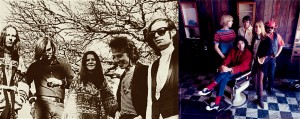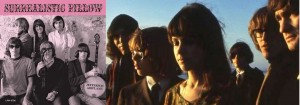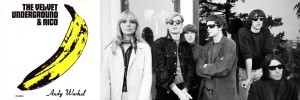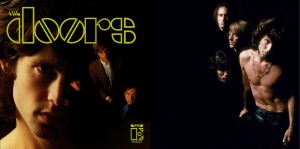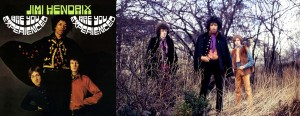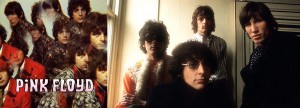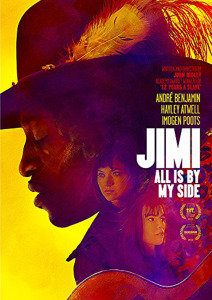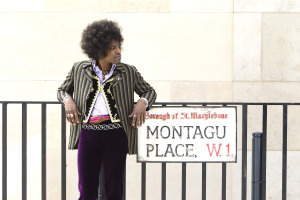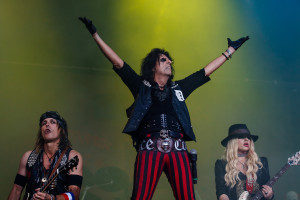(October 13, 2017; THE FAMILY ARENA, Saint Charles MO)
When this show was announced, I was excited at the prospect of seeing two of my favorite performers – the Monkees’ Micky Dolenz and Mark Lindsay of Paul Revere and the Raiders fame – doing some of my favorite songs in solo sets, a la the HAPPY TOGETHER packages of the past. After speaking to Lindsay about the show, I was even more excited, as I learned that this was a full-on production that features both vocalists onstage together, sharing songs, stories and memories. I previously likened the concept to the early live work of Dean Martin and Jerry Lewis; meanwhile, in a recent interview with the Mule’s Kevin Renick, Dolenz said, “It’s a little bit like a Rat Pack thing.” And, I suppose – if you suspend all disbelief and squint your eyes just right – a case could also be made for the Bonos (circa THE SONNY AND CHER COMEDY HOUR). However you look at it, the “A Little Bit Me, a Little Bit You” aspect of a show starring Mark Lindsay and Micky Dolenz is a dream come true for any child of the 1960s.

Opening the show was the Fab Four, hailed as “the Ultimate Tribute,” performing to perfection a set of Beatles tunes that the lads never performed live. Decked out in the Beatles’ SERGEANT PEPPER’S LONELY HEARTS CLUB BAND attire, the Four looked and sounded like the originals as they played and quipped their way through a packed 40-minute set. Led by founder Ron McNeil as John Lennon, the group – quite naturally – focused on material from the groundbreaking 1967 album, including (of course) the title track, “With a Little Help From My Friends,” “Strawberry Fields Forever,” (the non-album single from the same recording sessions, as well as its equally brilliant B-side, “Penny Lane”) and the heady, atmospheric “A Day In the Life.” All of George Martin”s studio trickery and embellishments, by the way, were performed live by the quartet, via the keyboard work of McNeil and Doug Couture’s George Harrison… no mean trick, that. The group also visited REVOLVER for “Got To Get You Into My Life,” and the brilliantly dreary “Eleanor Rigby,” one of my all-time favorite Beatles tunes. Nestled in the middle of all of this amazing music was “Yellow Submarine,” along with another of my personal favorites (but then, aren’t they all?), “Day Tripper.” What a great way to kick off the night!

After a short intermission, the Fab Four were back onstage… this time in Raiders costumes. McNeil introduced the headlining duo, Mark Lindsay first, then Micky Dolenz, as the band launched into “(I’m Not Your) Steppin’ Stone,” a song recorded by both the Monkees and Paul Revere and the Raiders. Mark told Micky, “I recorded it first,” to which Micky replied “I had the hit.” The hits came fast and furious from there, with the duo performing their own songs, as well as each other’s. The Raiders tune “Steppin’ Out” gave way to the Monkees’ “Last Train To Clarksville,” a tune that had the revved-up crowd up and dancing. The Raiders’ first “woulda, coulda, shoulda” non-hit, “Louie, Louie” (the Kingsmen recorded the song around the same time they did and rode their version to the top of the charts) followed hot on the heels of that one.

While the sound was generally solid, it was not without problems; some of the between-song banter (mostly Lindsay’s) was lost to the cavernous rafters of the Family Arena; as the sound tech worked out the kinks, their were sudden over-modulations of bass or guitar. But, those minor issues aside, the group of musicians onstage (including Micky’s sister, Coco on vocals and his “personal” guitarist, Wayne Avers) sounded phenomenal. Coco’s vocals, in particular, caught my attention, as she added that one extra layer that pushed the proceedings from a solid recreation of the songs we all know and love to a “Holy crap! This sounds just like the record.” level. From a rocker’s standpoint, the backing band had a harder edge. And, that’s not a bad thing… these songs are fifty years old and the relative youth of the Fab Four has infused both the songs and the singers with a new vitality. Tunes like “Hungry,” “Good Thing” and Mike Nesmith’s “Mary Mary” crackled and ignited under the pure weight of the Rock ‘n’ Roll offered up by the players, pushing Micky and Mark to ever greater heights.

As we knew they must, the reflections soon turned to this dynamic duo’s time on the small screen, with Lindsay ribbing Micky about “hanging out behind a circus tent with Cheetah and Tarzan,” in reference to Dolenz’ childhood role as CIRCUS BOY in 1956. After a little back and forth, the band launched into the theme song from WHERE THE ACTION IS, the Dick Clark vehicle that propelled Lindsay and the Raiders to superstardom, followed by the theme to THE MONKEES, which ended with a sort of modified “Monkees walk” by the pair. An outrageously bizarre video from WHERE THE ACTION IS featured Dolenz and fellow Monkee, Davy Jones, disrupting and dismantling a performance by Paul Revere and the Raiders. Laughing, Micky said, “I really don’t remember that… at all!” Of course, I think we all knew that someone would eventually broach the subject of opening acts. There was mention made of the Rolling Stones in regards to Paul Revere and the Raiders before Lindsay asked Micky about a certain short-lived opening act on the Monkees’ first major tour. “Yeah,” quipped Dolenz, “this is what Jimi Hendrix sounded like opening for the Monkees… ” as the group pushed into the opening of “Purple Haze.” Two lines into the vocals, Micky began screaming, “We want the Monkees! Where’s Davy? Where are the Monkees?” As the saying goes, “mistakes were made, people were blamed.” Somewhere along the way, Mark noticed that there was something off about the Fab Four’s Raiders’ outfits and produced a feather-adorned tri-corner Colonial hat for the only “Raider” not wearing one, Ron McNeil as Paul Revere; with his back to the band, Lindsay continued his spiel, as Micky quietly replaced Doug Couture’s (not absolutely positive, but relatively sure of the name) hat with a green wool cap, a la Mike Nesmith. A small thing, to be sure, but it definitely registered with the gleeful crowd.

How can you qualify the sheer quantity of great music that came out of the mid-to-late ‘60s, many by the two legendary figures onstage tonight? I mean, “Kicks,” “Pleasant Valley Sunday,” “Him Or Me – What’s It Gonna Be,” “I’m a Believer.” Toss in the lesser-known (though no less impressive) “She,” “Randy Scouse Git” and the psychedelic Blues work-out of “For Pete’s Sake” and you have not only an incredible set list for this show, but along with the Fab Four’s set, you have the soundtrack to the lives of many a baby boomer. Highlight upon highlight drove the performers and the audience to give a little bit more as the evening progressed. Things bordered on transcendent for me when Lindsay and Dolenz discussed their heritage, leading into the spine-shivering intro to “Indian Reservation.” I say again that both vocalists were in top form throughout the show, but it just seemed to me that Mark kicked things up a notch for what was Paul Revere and the Raiders’ biggest hit… a protest, an anthem, a song for the ages.

After a final, brilliant turn by Micky Dolenz on “I’m a Believer,” it was over. Well, not really… I mean, you know how these things work, right? After a very short break, the band returned, with McNeil introducing Mark and Micky back to the stage for the encore, which included one of the Monkees’ most beloved tunes, “Daydream Believer.” The night ended with a rousing “Twist and Shout,” an early hit for the Beatles, with Dolenz delivering the first couple of lines before turning vocal duties over to “John.” As the lights came up, the buzz in the air wasn’t from the amplifiers; it came from the excited, appreciative crowd. And, why not? They had just witnessed two of the greatest performers and purest voices of the Rock era put on the show of their lives.



